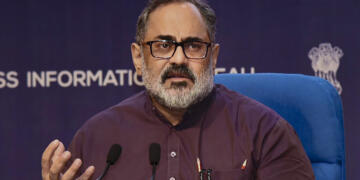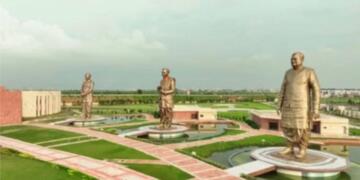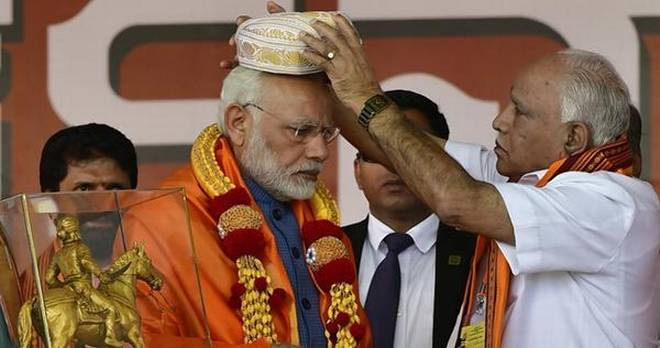In the recently concluded Karnataka assembly elections, the Bharatiya Janata Party (BJP) emerged as the single largest party by winning an impressive 104 seats out of the 222 where the elections were held on 12 May 2018. This was 64 more than what the party had won back in 2013. However, it was still just short of the majority mark of 112. In the week long drama that took place, finally the BJP had to sit in the opposition and an alliance of convenience which was forged between the Indian National Congress (INC) and the Janata Dal (Secular) (JDS) came to form the government and HD Kumaraswamy was sworn in as the Chief Minister on 23 May 2018 in a ceremony which turned out to be a “show of strength” for the opposition parties.
However, before all this, on 19 May 2018, BJP leader and the then Chief Minister BS Yeddyurappa recreated the Atal Bihari Vajpayee moment of 1996 in the Vidhana Soudha. In a blistering speech, he tore apart his rival parties, the JDS and the Congress before announcing his resignation on the floor of the house ahead of the trust vote. In his speech, he declared that he will work towards ensuring that the BJP wins all the 28 seats in Karnataka in the Lok Sabha elections that will be held next year.
Whether the BJP will be able to win all 28 seats in Karnataka is debatable but the party will definitely be in shape to better its current tally of 17 and win more than 20 seats. In the recently conducted assembly elections, the people’s mandate was definitely against the Congress with it being reduced to 78 from 122. As many as 17 ministers in the Siddaramaiah led government bit the dust with the Chief Minister himself being embarrassed in his home district Mysuru where he lost by a whopping 36,000 votes to the JDS candidate GT Deve Gowda in Chamundeshwari constituency.
The two dominant communities in Karnataka, namely the Lingayat and the Vokkaliga communities both voted against the Congress party. The Lingayat gamble of the Congress party has failed miserably and the BJP has won majority of the seats in the Lingayat dominated Central Karnataka as well as in the Bombay Karnataka regions and has put up a good show in the Hyderabad Karnataka region. Lingayats are significant in 18 out of the 28 Lok Sabha constituencies in Karnataka. The consolidation of the Vokkaliga votes was the reason why the JDS managed to win 37 seats in the assembly, majority of which came in the Old Mysuru region. It is quite clear that the mood of the people is very much against the Congress and the JDS by allying with the Congress has only made it that much better for the BJP because people will now view this as a betrayal of their mandate in which they had voted against the Congress.
What the Karnataka elections showed is that Prime Minister Narendra Modi is immensely popular across the state. It also proved that BS Yeddyurappa is one of the tallest leaders in Karnataka and under his leadership; the BJP can do very well. The combination worked wonderfully well which is how the BJP was able to win 104 seats. BSY was the opening batsman who saw off the dangerous new ball phase and laid the platform for the innings to commence through his parivartana rally which covered the entire state of Karnataka and PM Modi acted like a finisher whose 21 rallies across the state in which he made extensive of symbolism to win the hearts of Kannadigas helped the party cross 100.
One of the blunders made by the outgoing Chief Minister Siddaramaiah was that he made the election into a Siddaramaiah vs Modi battle which backfired badly on him due to Modi’s immense popularity in Karnataka. Meanwhile, he might have had to resign as CM after just two days in charge, but BSY has always come back stronger and he will be doubly determined to ensure that the BJP gets more than 20 seats in the Lok Sabha elections. By recreating the Vajpayee moment of 1996, he has ensured that people’s sympathies will be with him. BSY’s mass appeal and immense experience, Amit Shah’s strategy, and Modi’s immense popularity can definitely propel the BJP to an impressive tally in the 2019 Lok Sabha elections.
Also, recent history suggests that the BJP is the most popular party in Karnataka as far as Lok Sabha elections are concerned. This has been the trend since 2004. In the 2004 elections, the BJP emerged as the party with the most seats in Karnataka by winning 18 seats out of 28. The BJP has been often referred to as a North Indian party at times but in 2009 elections, when the UPA was at its peak, guess which state provided the BJP with its highest tally out of the 116 seats won by the party? It was Karnataka! The BJP won an impressive 19 out of 28 seats and also got the highest vote share of 41.63% in the state. And in 2014, the BJP did a hat trick by once again emerging as the party with the most seats by winning 17 out of 28. This, just about a year after the party had been decimated in the 2013 assembly elections. The tally of 17 Lok Sabha seats comprises of 130 assembly constituencies. Although there was a drop of 2 seats when compared to 2009, there was an increase in the vote share which was now 43%, about 2.2% more than that of its nearest rival, the Congress Party.
It can be observed that not only has the BJP emerged as the party with most seats in the Lok Sabha elections as far as Karnataka is concerned, its vote share has also increased in the state with each election from 2004 to 2014. Even if the JDS-Congress alliance is in place in the 2019 elections, it will not make much of a difference for the BJP. Both the JDS and the Congress have similar strengths and weaknesses. The JDS hardly has a presence in the state except for the Old Mysuru region. After failing to get majority on its own, the BJP would now be more motivated towards establishing its base in Old Mysuru region which is the only region in the state where the party is a bit weak. However, this might change by the time of the 2019 elections.

































